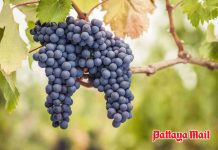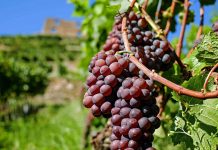Here’s a quiz question for you. Which two grape varieties are most frequently used to make sparkling wine? If you were to answer “Cabernet Sauvignon and Merlot” I’d have to give you a poke with a pointed stick and send you to the back of the class, because the answer is Chardonnay and Pinot Noir. Mind you, in theory you could make sparkling wine – of sorts – from virtually any grape. In Spain, they make sparking Cava from the obscure trio of Parellada, Xarel-lo and Macabeo. In Australia they make sparkling Shiraz and in Italy, Asti is made from the Moscato grape. It’s just that some grapes make better sparklers than others.
Sparkling wines are nearly always white or pink. Sparkling red wines are rare. Wine-writer Hugh Johnson once remarked that “there is something absurd about sparkling red wine. It’s like a fat old man dressed up as a fairy.” Come to think of it, in this neck of the woods, it probably wouldn’t be entirely out of place.
In the world of sparkling wine, Champagne sits at the top of the tree. If your taste runs to genuine Champagne, then you’ll find nothing much under three or four thousand baht around here. This is because the manufacturing process, known as the Méthode Champenoise is complicated, long-winded and expensive. A cheaper alternative is the Charmat Method and is now used widely to produce light, delicate sparkling wines.
The pressure inside a bottle of sparkling wine is about the same as that inside a bus tyre, so treat it with respect. On absolutely no account shake the bottle in the vulgar manner of racing car drivers. And incidentally, the cork should emerge with a gentle gasping “shlop” sound, not an explosive bang. That horrid popping noise instantly lowers the tone of any social occasion.
“Santa Julia” Sparkling Extra Brut (white), Argentina (Central and Tops, Bt. 599)
Here’s a lovely transparent gold-coloured wine with the tiniest hints of pink. From the distinguished Zuccardi family, it’s an interesting blend of Chardonnay (35%), Viognier (10%) and Pinot Noir (55%) which probably accounts for the subtle pinkish hue.
 Vineyard workers at Zuccardi Winery, Argentina.
Vineyard workers at Zuccardi Winery, Argentina.
Made by the Charmat Method, it has a fresh, subtle floral aroma that suggests green apples, apricots, white peaches and pineapples. There are plenty of tiny bubbles in the glass, the fruit well forward and the wine crisp and light-bodied. It’s extremely dry and refreshing with a good dash of citric acidity which also comes through on the long dry finish. I even thought I could detect a faint taste of honey too. This is a very attractive sprightly wine which would be brilliant as a pre-dinner apéritif, because the crisp freshness would set the taste-buds a-tingling.
By the way, the word “Brut” (BROOT) is used rather confusingly on champagne and sparkling wine labels to mean wines that are dryer than those labelled “extra dry”. Needless to say, “Extra Brut” denotes a wine that is extremely or totally dry, very much like this one.
“Joy” Sparkling Brut 2011 (white), South Africa (Central and Tops, Bt. 499)
Here’s a lovely champagne-style wine that comes under the “Joy” label from Central. It’s made from the Muscat d’ Alexandrie grape by the well-known Bouma Company in Stellenbosch. With the purchase of every bottle, a thirty baht donation will be made to Father Joe Maier’s Mercy Centre in Bangkok.
This wine appears much less dry than the Santa Julia (largely due to lower acidity and the sweeter grapes) and has a soft mouth-feel, bags of fruit on the taste and very gentle acidity. Also made by the Charmat Method, it looks good too, especially if you serve it in a tall champagne flute. It’s straw-coloured with a greenish tinge and a fabulous sweet rose-like floral aroma, with raisins, pears and strawberries in the background and a long citrus finish. It’s a young vibrant off-dry wine at around 13.5% alcohol content and it should win many friends. Served very cold, it would make a delightful apéritif or party-starter. If you put the bottle in an ice-bucket and cover it with a tasteful white cloth, I bet some of your friends will think they’re drinking champagne. But far be it from me to encourage dishonesty.




